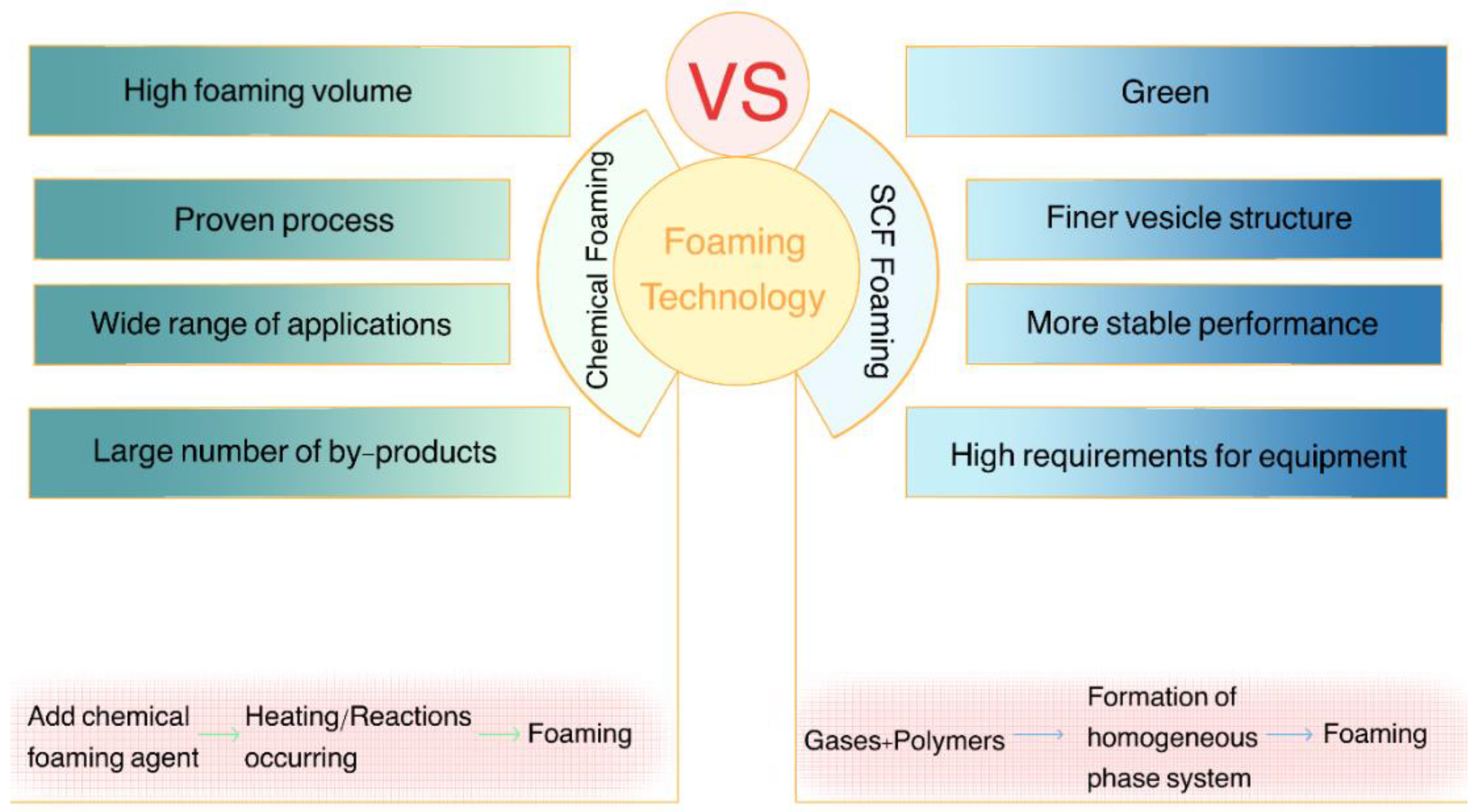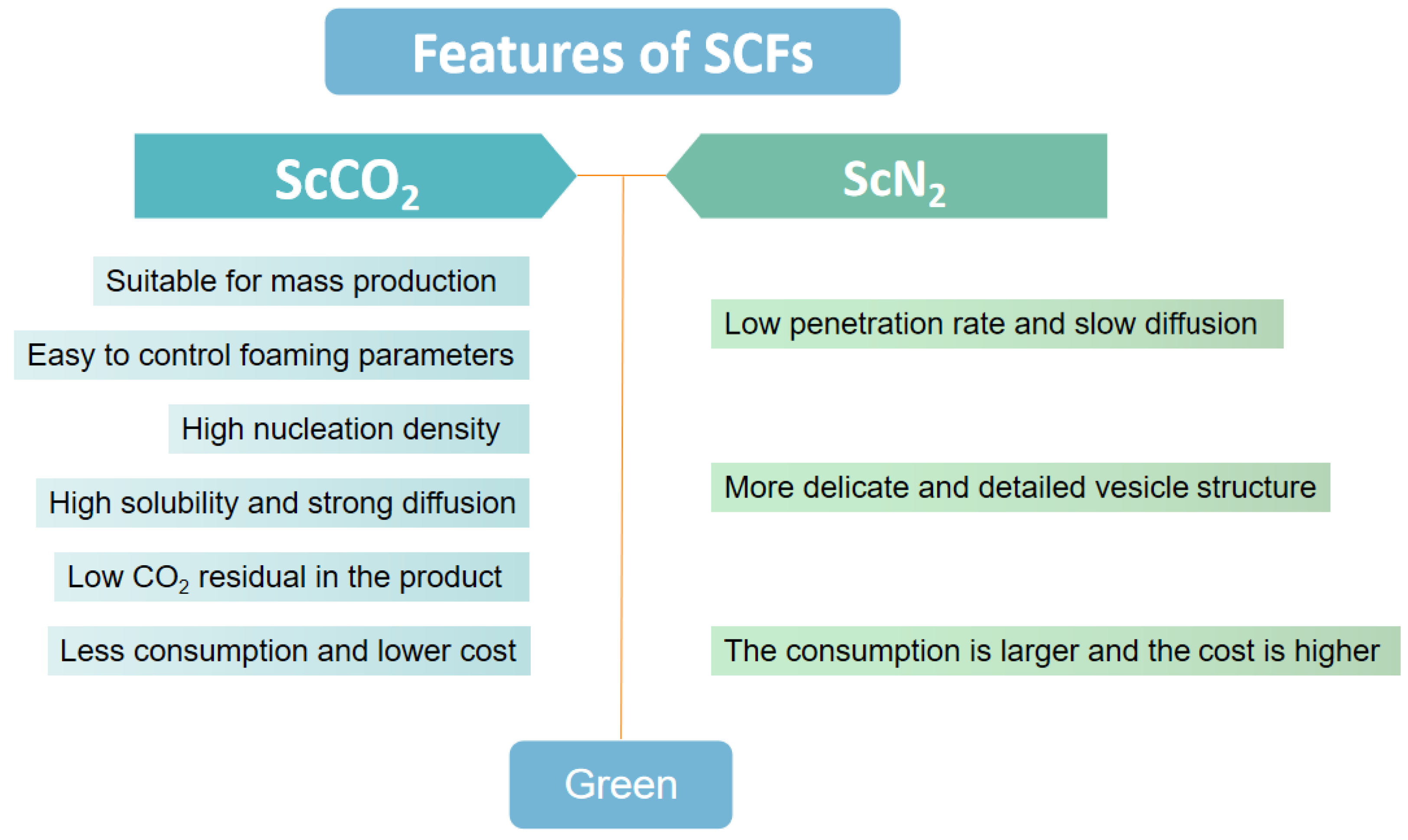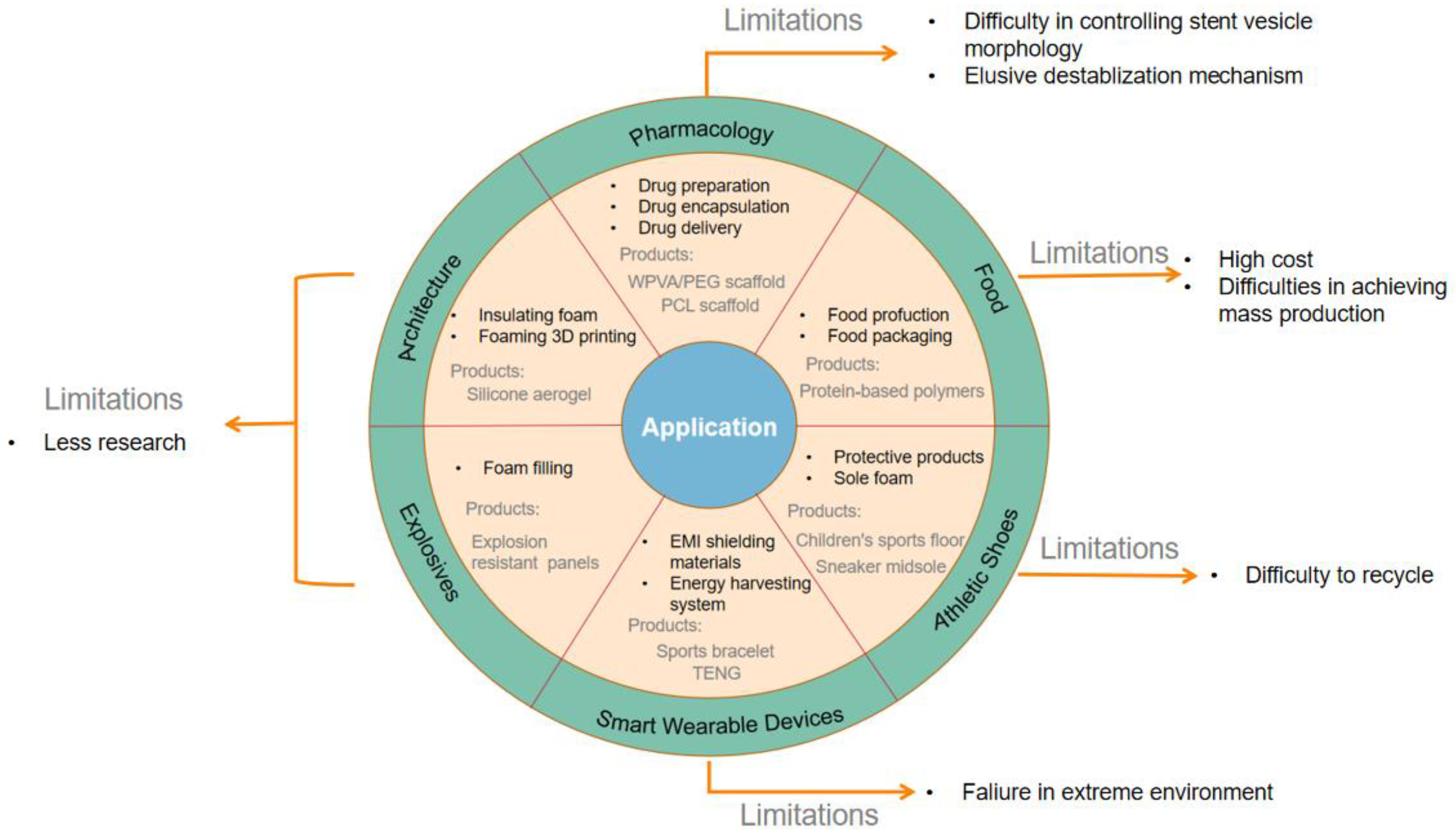Applications and Challenges of Supercritical Foaming Technology
Abstract
1. Introduction
2. Types of Foaming Agents
2.1. ScCO2
2.2. ScN2
2.3. Co-Foamer
3. Application Status
3.1. Pharmacology
3.2. Food
3.3. Athletic Shoes
3.4. Smart Wearable Devices
3.5. Explosives
3.6. Architecture
4. Assessment of Enabling Technology Development
4.1. RIC-FIM Technology
4.2. Combined with Cross-Linking Technology
4.3. Combined with Particle Leaching Technology
4.4. Add Filler
4.5. Combined with 3D Printing Technology

| Technology | Development | Means of Implementation | Ref |
|---|---|---|---|
| RIC-FIM | Simplify installations and reduce costs | The transmission of PBA does not require high-pressure pumps or injection valves | [15] |
| Cross-linking | Increase the density of bubble pores and enhance the foaminess | Mainly radiation crosslinking | [44] |
| Particle leaching | Overcoming foam pore size adjustment problems | Porogen leaching techniques. | [48] |
| Add filler | Change the bubble structure and mechanical properties of the foam | Add wood flour or other filler | [11] |
| 3D printing | Production of foam products with complex structures | Selective laser sintering (SLS) printing and more | [51] |
5. Remaining Challenges and Future Research
5.1. Technical Limitations
5.2. Limitation of Foaming Agent
5.3. Technology Cost
5.4. Recycling
6. Conclusions
Author Contributions
Funding
Institutional Review Board Statement
Data Availability Statement
Acknowledgments
Conflicts of Interest
References
- Di Maio, E.; Kiran, E. Foaming of polymers with supercritical fluids and perspectives on the current knowledge gaps and challenges. J. Supercrit. Fluids 2018, 134, 157–166. [Google Scholar] [CrossRef]
- Knez, Ž.; Markočič, E.; Leitgeb, M.; Primožič, M.; Hrnčič, M.K.; Škerget, M. Industrial applications of supercritical fluids: A review. Energy 2014, 77, 235–243. [Google Scholar] [CrossRef]
- Macawile, M.C.; Auresenia, J. Utilization of Supercritical Carbon Dioxide and Co-solvent n-hexane to Optimize Oil Extraction from Gliricidia sepium Seeds for Biodiesel Production. Appl. Sci. Eng. Prog. 2021, 15, 5404. [Google Scholar] [CrossRef]
- Macawile, M.C.; Auresenia, J. Comparison of biodiesel yield from seed oils extracted by ultrasound-assisted chemical solvent and supercritical CO2 methods. Int. J. Appl. Sci. Eng. 2022, 19, 2021279. [Google Scholar] [CrossRef]
- Zhang, Z.X.; Zhang, T.; Wang, D.; Zhang, X.; Xin, Z.; Prakashan, K. Physicomechanical, friction, and abrasion properties of EVA/PU blend foams foamed by supercritical ni-trogen. Polym. Eng. Sci. 2018, 58, 673–682. [Google Scholar] [CrossRef]
- Kravanja, K.A.; Finšgar, M.; Knez, Ž.; Marevci, M.K. Supercritical Fluid Technologies for the Incorporation of Synthetic and Natural Active Compounds into Materials for Drug Formulation and Delivery. Pharmaceutics 2022, 14, 1670. [Google Scholar] [CrossRef]
- Zhang, S.; Shi, X.; Miao, Z.; Zhang, H.; Zhao, X.; Wang, K.; Qin, J.; Zhang, G. 3D-Printed Polyurethane Tissue-Engineering Scaffold with Hierarchical Microcellular Foam Structure and Antibacterial Properties. Adv. Eng. Mater. 2022, 24, 2101134. [Google Scholar] [CrossRef]
- Gu, P.; Xu, Y.; Liu, Q.; Wang, Y.; Li, Z.; Chen, M.; Mao, R.; Liang, J.; Zhang, X.; Fan, Y.; et al. Tailorable 3DP Flexible Scaffolds with Porosification of Filaments Facilitate Cell Ingrowth and Biomineralized Deposition. ACS Appl. Mater. Interfaces 2022, 14, 32914–32926. [Google Scholar] [CrossRef]
- Montes, A.; Valor, D.; Delgado, L.; Pereyra, C.; Martínez de la Ossa, E. An Attempt to Optimize Supercritical CO2 Polyani-line-Polycaprolactone Foaming Processes to Produce Tissue Engineering Scaffolds. Polymers 2022, 14, 488. [Google Scholar] [CrossRef]
- Song, Y.; Phule, A.D.; Yu, Z.; Zhang, X.; Du, A.; Wang, H.; Zhang, Z.X. Lightweight and flexible silicone rubber foam with dopamine grafted multi-walled carbon nanotubes and silver nanoparticles using supercritical foaming technology: Its preparation and electromagnetic interference shielding performance. Eur. Polym. J. 2021, 161, 110839. [Google Scholar] [CrossRef]
- Jiménez, J.A.V.; Le Moigne, N.; Bénézet, J.-C.; Sauceau, M.; Sescousse, R.; Fages, J. Foaming of PLA Composites by Supercritical Fluid-Assisted Processes: A Review. Molecules 2020, 25, 3408. [Google Scholar] [CrossRef]
- Li, Y.; Gong, P.; Liu, Y.; Niu, Y.; Park, C.B.; Li, G. Environmentally Friendly and Zero-Formamide EVA/LDPE Microcellular Foams via Supercritical Carbon Dioxide Solid Foaming. ACS Appl. Polym. Mater. 2021, 3, 4213–4222. [Google Scholar] [CrossRef]
- Salerno, A.; Domingo, C. Polycaprolactone foams prepared by supercritical CO2 batch foaming of polymer/organic solvent solutions. J. Supercrit. Fluids 2019, 143, 146–156. [Google Scholar] [CrossRef]
- Santos-Rosales, V.; Ardao, I.; Goimil, L.; Gomez-Amoza, J.; García-González, C. Solvent-Free Processing of Drug-Loaded Poly(ε-Caprolactone) Scaffolds with Tunable Macroporosity by Combination of Supercritical Foaming and Thermal Porogen Leaching. Polymers 2021, 13, 159. [Google Scholar] [CrossRef] [PubMed]
- Wang, L.; Hikima, Y.; Ohshima, M.; Yusa, A.; Yamamoto, S.; Goto, H. Development of a Simplified Foam Injection Molding Technique and Its Application to the Production of High Void Fraction Polypropylene Foams. Ind. Eng. Chem. Res. 2017, 56, 13734–13742. [Google Scholar] [CrossRef]
- Shao, Y.; Luo, C.; Deng, B.; Yin, B.; Yang, M. Flexible porous silicone rubber-nanofiber nanocomposites generated by super-critical carbon dioxide foaming for harvesting mechanical energy. Nano Energy 2020, 67, 104290. [Google Scholar] [CrossRef]
- Sun, L.; Gao, M.; Tang, S. Porous amino acid-functionalized poly (ionic liquid) foamed with supercritical CO2 and its ap-plication in CO2 adsorption. Chem. Eng. J. 2021, 412, 128764. [Google Scholar] [CrossRef]
- Sauceau, M.; Fages, J.; Common, A.; Nikitine, C.; Rodier, E. New challenges in polymer foaming: A review of extrusion processes assisted by supercritical carbon dioxide. Prog. Polym. Sci. 2011, 36, 749–766. [Google Scholar] [CrossRef]
- Hu, D.-D.; Gu, Y.; Liu, T.; Zhao, L. Microcellular foaming of polysulfones in supercritical CO2 and the effect of co-blowing agent. J. Supercrit. Fluids 2018, 140, 21–31. [Google Scholar] [CrossRef]
- Feng, D.; Li, L.; Wang, Q. Fabrication of three-dimensional polyetherimide bead foams via supercritical CO2/ethanol co-foaming technology. RSC Adv. 2019, 9, 4072–4081. [Google Scholar] [CrossRef]
- Liu, P.; Chen, W.; Liu, C.; Tian, M.; Liu, P. A novel poly (vinyl alcohol)/poly (ethylene glycol) scaffold for tissue engineering with a unique bimodal open-celled structure fabricated using supercritical fluid foaming. Sci. Rep. 2019, 9, 9534. [Google Scholar] [CrossRef]
- Franco, P.; Belvedere, R.; Pessolano, E.; Liparoti, S.; Pantani, R.; Petrella, A.; De Marco, I. PCL/Mesoglycan Devices Obtained by Supercritical Foaming and Impregnation. Pharmaceutics 2019, 11, 631. [Google Scholar] [CrossRef] [PubMed]
- Ong, Y.X.J.; Lee, L.Y.; Davoodi, P.; Wang, C.-H. Production of drug-releasing biodegradable microporous scaffold using a two-step micro-encapsulation/supercritical foaming process. J. Supercrit. Fluids 2018, 133, 263–269. [Google Scholar] [CrossRef]
- Li, B.; Zhao, G.; Wang, G.; Zhang, L.; Gong, J. Fabrication of high-expansion microcellular PLA foams based on pre-isothermal cold crystallization and supercritical CO2 foaming. Polym. Degrad. Stab. 2018, 156, 75–88. [Google Scholar] [CrossRef]
- Ivanovic, J.; Rezwan, K.; Kroll, S. Supercritical CO2 deposition and foaming process for fabrication of biopolyester-ZnO bone scaffolds. J. Appl. Polym. Sci. 2018, 135, 45824. [Google Scholar] [CrossRef]
- Salerno, A.; Leonardi, A.B.; Pedram, P.; Di Maio, E.; Fanovich, M.A.; Netti, P.A. Tuning the three-dimensional architecture of supercritical CO2 foamed PCL scaffolds by a novel mould pat-terning approach. Mater. Sci. Eng. C 2020, 109, 110518. [Google Scholar] [CrossRef]
- Parsa, M.; Trybala, A.; Malik, D.J.; Starov, V. Foam in pharmaceutical and medical applications. Curr. Opin. Colloid Interface Sci. 2019, 44, 153–167. [Google Scholar] [CrossRef]
- Bartella, L.; Mazzotti, F.; Talarico, I.R.; Santoro, I.; Di Donna, L. Hydroxytyrosol-Fortified Foods Obtained by Supercritical Fluid Extraction of Olive Oil. Antioxidants 2021, 10, 1619. [Google Scholar] [CrossRef] [PubMed]
- Singh, S.; Verma, D.K.; Thakur, M.; Tripathy, S.; Patel, A.R.; Shah, N.; Utama, G.L.; Srivastav, P.P.; Benavente-Valdés, J.R.; Chávez-González, M.L.; et al. Supercritical fluid extraction (SCFE) as green extraction technology for high-value metabolites of algae, its potential trends in food and human health. Food Res. Int. 2021, 150, 110746. [Google Scholar] [CrossRef]
- Ding, L.; Zhao, Q.; Zhou, X.; Tang, C.; Chen, Y.; Cai, Z. Changes in protein structure and physicochemical properties of egg white by supercritical carbon dioxide treatment. J. Food Eng. 2020, 284, 110076. [Google Scholar] [CrossRef]
- Tsagdi, A.; Drossos, I.; Georgiou, D.; Exarhopoulos, S.; Karasiotas, G.; Kallitsis, J.; Kalogianni, E. Injection Molded PP Foams Using Food Ingredients for Food Packaging Applications. Polymers 2021, 13, 288. [Google Scholar] [CrossRef]
- Lopresti, F.; Botta, L.; Scaffaro, R.; Bilello, V.; Settanni, L.; Gaglio, R. Antibacterial biopolymeric foams: Structure–property relationship and carvacrol release kinetics. Eur. Polym. J. 2019, 121, 109298. [Google Scholar] [CrossRef]
- Li, N.; Fan, D.; Shi, Z.; Xie, Y.; Li, M.; Tang, T. Effect of ion-crosslinking on supercritical CO2 foaming behavior and foam properties of EVA/ZnO composites. Compos. Commun. 2021, 25, 100760. [Google Scholar] [CrossRef]
- Sipaut, C.S.; Halim, H.A.; Jafarzadeh, M. Processing and properties of an ethylene-vinyl acetate blend foam incorporating ethylene-vinyl acetate and polyurethane waste foams. J. Appl. Polym. Sci. 2017, 134, 44708. [Google Scholar] [CrossRef]
- Song, L.; Huang, Z.; Guo, S.; Li, Y.; Wang, Q. Hierarchically Architected Polyvinylidene Fluoride Piezoelectric Foam for Boosted Mechanical Energy Harvesting and Self-Powered Sensor. ACS Appl. Mater. Interfaces 2021, 13, 37252–37261. [Google Scholar] [CrossRef]
- Yang, J.; Liao, X.; Wang, G.; Chen, J.; Guo, F.; Tang, W.; Wang, W.; Yan, Z.; Li, G. Gradient structure design of lightweight and flexible silicone rubber nanocomposite foam for efficient electro-magnetic interference shielding. Chem. Eng. J. 2020, 390, 124589. [Google Scholar] [CrossRef]
- Yao, B.; Xu, X.; Li, H.; Han, Z.; Hao, J.; Yang, G.; Xie, Z.; Chen, Y.; Liu, W.; Wang, Q.; et al. Soft liquid-metal/elastomer foam with compression-adjustable thermal conductivity and electromagnetic inter-ference shielding. Chem. Eng. J. 2021, 410, 128288. [Google Scholar] [CrossRef]
- Tan, D.; Zhang, D.; Wang, Y.; Xiao, F.; Chen, F.; Wei, X. Effect of Pressure of Supercritical CO2 on Perfusion Explosive with Foamed SF-3 Propellant. Propellants Explos. Pyrotech. 2021, 46, 1740–1745. [Google Scholar] [CrossRef]
- Tan, D.; Wang, Y.; Guo, B.; Chen, F.; Wei, X. Application of Supercritical CO2 Foaming Technology for Waste Double-Base Propellants. ACS Omega 2021, 6, 30555–30561. [Google Scholar] [CrossRef] [PubMed]
- Zhang, P.; Cheng, Y.; Liu, J.; Li, Y.; Zhang, C.; Hou, H.; Wang, C. Experimental study on the dynamic response of foam-filled corrugated core sandwich panels subjected to air blast loading. Compos. Part B Eng. 2016, 105, 67–81. [Google Scholar] [CrossRef]
- Bedarf, P.; Dutto, A.; Zanini, M.; Dillenburger, B. Foam 3D printing for construction: A review of applications, materials, and processes. Autom. Constr. 2021, 130, 103861. [Google Scholar] [CrossRef]
- Song, Z.; Zhao, Y.; Yuan, M.; Huang, L.; Yuan, M.; Cui, S. Thermal Insulation and Moisture Resistance of High-Performance Silicon Aerogel Composite Foam Ceramic and Foam Glass. Adv. Eng. Mater. 2022, 24, 2101508. [Google Scholar] [CrossRef]
- Ikutegbe, C.A.; Farid, M.M. Application of phase change material foam composites in the built environment: A critical review. Renew. Sustain. Energy Rev. 2020, 131, 110008. [Google Scholar] [CrossRef]
- Yang, C.; Xing, Z.; Zhao, Q.; Wang, M.; Wu, G. A strategy for the preparation of closed-cell and crosslinked polypropylene foam by supercritical CO2 foaming. J. Appl. Polym. Sci. 2017, 135, 45809. [Google Scholar] [CrossRef]
- Ma, L.Y.; Zhao, Y.; Yu, Z.; Zhang, Z.X.; Wen, S. Development of fluororubber foam by supercritical N 2 foaming through irradiation pre-crosslinking and secondary cross-linking. Polym. Adv. Technol. 2022, 33, 3437–3446. [Google Scholar] [CrossRef]
- Yang, C.-G.; Wang, M.-H.; Zhang, M.-X.; Li, X.-H.; Wang, H.-L.; Xing, Z.; Ye, L.-F.; Wu, G.-Z. Supercritical CO2 Foaming of Radiation Cross-Linked Isotactic Polypropylene in the Presence of TAIC. Molecules 2016, 21, 1660. [Google Scholar] [CrossRef] [PubMed]
- Xin, X.; Liu, Q.-Q.; Chen, C.-X.; Guan, Y.-X.; Yao, S.-J. Fabrication of bimodal porous PLGA scaffolds by supercritical CO2 foaming/particle leaching technique. J. Appl. Polym. Sci. 2016, 133, 43644. [Google Scholar] [CrossRef]
- Salerno, A.; Zeppetelli, S.; Di Maio, E.; Iannace, S.; Netti, P. Architecture and properties of bi-modal porous scaffolds for bone regeneration prepared via supercritical CO2 foaming and porogen leaching combined process. J. Supercrit. Fluids 2012, 67, 114–122. [Google Scholar] [CrossRef]
- Zhang, K.; Wang, Y.; Jiang, J.; Wang, X.; Hou, J.; Sun, S.; Li, Q. Fabrication of highly interconnected porous poly(ε-caprolactone) scaffolds with supercritical CO2 foaming and polymer leaching. J. Mater. Sci. 2019, 54, 5112–5126. [Google Scholar] [CrossRef]
- Santos-Rosales, V.; Iglesias-Mejuto, A.; García-González, C. Solvent-Free Approaches for the Processing of Scaffolds in Regenerative Medicine. Polymers 2020, 12, 533. [Google Scholar] [CrossRef]
- Yang, C.; Song, S.; Chen, F.; Chen, N. Fabrication of PVDF/BaTiO3/CNT Piezoelectric Energy Harvesters with Bionic Balsa Wood Structures through 3D Printing and Supercritical Carbon Dioxide Foaming. ACS Appl. Mater. Interfaces 2021, 13, 41723–41734. [Google Scholar] [CrossRef] [PubMed]
- Nofar, M.; Utz, J.; Geis, N.; Altstädt, V.; Ruckdäschel, H. Foam 3D Printing of Thermoplastics: A Symbiosis of Additive Manufacturing and Foaming Technology. Adv. Sci. 2022, 9, 2105701. [Google Scholar] [CrossRef] [PubMed]
- Trigo-López, M.; Vallejos, S.; Ruiz, J.A.R.; Ramos, C.; Beltrán, S.; García, F.C.; García, J.M. Fabrication of microporous PMMA using ionic liquids: An improved route to classical ScCO2 foaming process. Polymer 2019, 183, 121867. [Google Scholar] [CrossRef]
- Moran, J.L.; Cottrill, A.L.; Benck, J.D.; Liu, P.; Yuan, Z.; Strano, M.S.; Buongiorno, J. Noble-gas-infused neoprene closed-cell foams achieving ultra-low thermal conductivity fabrics. RSC Adv. 2018, 8, 21389–21398. [Google Scholar] [CrossRef]




Disclaimer/Publisher’s Note: The statements, opinions and data contained in all publications are solely those of the individual author(s) and contributor(s) and not of MDPI and/or the editor(s). MDPI and/or the editor(s) disclaim responsibility for any injury to people or property resulting from any ideas, methods, instructions or products referred to in the content. |
© 2023 by the authors. Licensee MDPI, Basel, Switzerland. This article is an open access article distributed under the terms and conditions of the Creative Commons Attribution (CC BY) license (https://creativecommons.org/licenses/by/4.0/).
Share and Cite
Zhou, Y.; Tian, Y.; Peng, X. Applications and Challenges of Supercritical Foaming Technology. Polymers 2023, 15, 402. https://doi.org/10.3390/polym15020402
Zhou Y, Tian Y, Peng X. Applications and Challenges of Supercritical Foaming Technology. Polymers. 2023; 15(2):402. https://doi.org/10.3390/polym15020402
Chicago/Turabian StyleZhou, Yujin, Yingrui Tian, and Xiaowei Peng. 2023. "Applications and Challenges of Supercritical Foaming Technology" Polymers 15, no. 2: 402. https://doi.org/10.3390/polym15020402
APA StyleZhou, Y., Tian, Y., & Peng, X. (2023). Applications and Challenges of Supercritical Foaming Technology. Polymers, 15(2), 402. https://doi.org/10.3390/polym15020402







